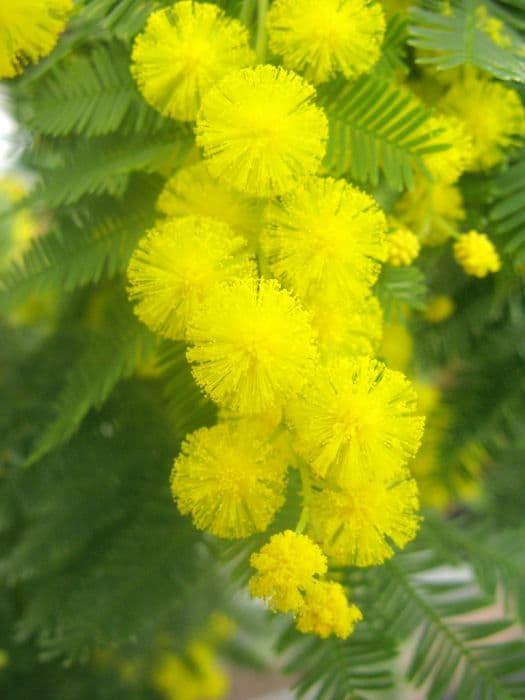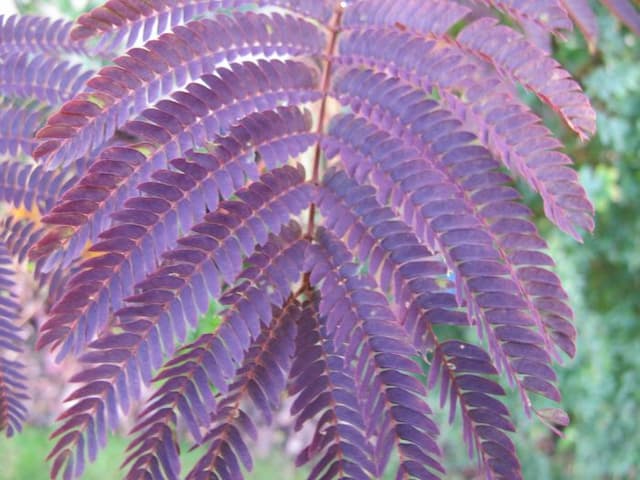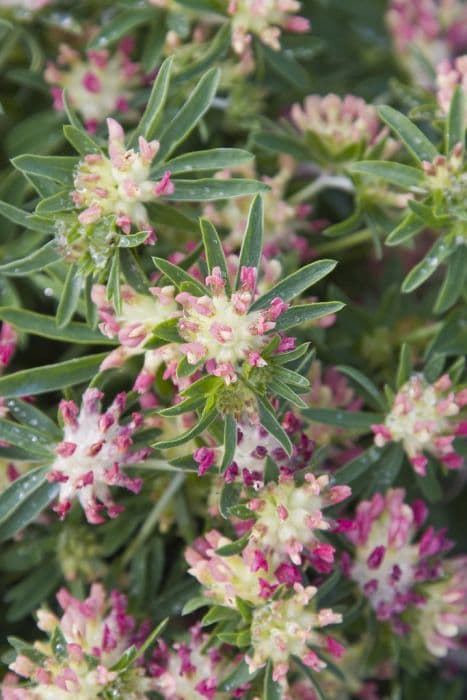Silver Wattle Acacia dealbata

ABOUT
The plant in question is commonly known as the silver wattle. It is characterized by a beautiful feathery foliage that is silver-grey to blue-green in color. The leaves are bipinnate, meaning they are divided into multiple pairs of leaflets, which themselves are often further divided, giving the foliage a fine, fern-like appearance. During its blooming season, the silver wattle becomes adorned with an abundance of small, bright yellow, fluffy ball-shaped flowers, which cluster together in showy inflorescences. These fragrant flowers give the plant a striking and vibrant look, contributing greatly to its ornamental value. The bark of the silver wattle is generally smooth and can vary in color from a light grey to a more earthy brown tone. It may also present a slightly textured appearance as the plant matures. Overall, the silver wattle's combination of delicate leaves and vivid blossoms creates a captivating visual spectacle, making it a popular choice in gardens and landscapes where it fits the local climate and soil conditions. It can be seen as a shrub or tree form, contributing to its versatility in various horticultural settings.
About this plant
 Names
NamesSynonyms
Silver Wattle, Mimosa, Blue Wattle
Common names
Acacia decurrens var. dealbata, Acacia decurrens var. dealbata, Acacia affinis, Acacia derwentii, Acacia puberula, Racosperma dealbatum.
 Toxicity
ToxicityTo humans
The plant commonly known as Silver Wattle (Acacia dealbata) can be toxic to humans if ingested. Although it is primarily not considered deadly, some parts of the plant contain compounds that can cause adverse reactions. Eating large quantities of the bark, foliage, or seeds may result in gastrointestinal upset such as nausea, vomiting, and diarrhea. Additionally, the seeds may potentially cause more serious issues due to the presence of toxic alkaloids. It is important for humans to avoid consuming any part of the Silver Wattle to prevent these unpleasant and potentially harmful symptoms.
To pets
Silver Wattle (Acacia dealbata) can also be toxic to pets if ingested. Similar to humans, animals may experience gastrointestinal distress if they consume parts of this plant. Symptoms in pets may include vomiting, diarrhea, and abdominal pain. In severe cases, the ingestion of significant quantities of the Silver Wattle's bark, leaves, or seeds could cause more serious health issues due to the toxic compounds present, such as alkaloids in the seeds. Therefore, it is crucial to prevent pets from consuming any part of the Silver Wattle to avoid the risk of poisoning.
 Characteristics
CharacteristicsLife cycle
Perennials
Foliage type
Evergreen
Color of leaves
Bluish-green
Flower color
Yellow
Height
20-30 feet (6-9 meters)
Spread
15-20 feet (4.5-6 meters)
Plant type
Tree
Hardiness zones
9
Native area
Australia
Benefits
 General Benefits
General Benefits- Ornamental Value: Acacia dealbata, commonly known as silver wattle, is often planted for its attractive fern-like foliage and bright yellow, fragrant flowers that bloom in early spring.
- Habitat for Wildlife: This plant provides shelter and food for birds, bees, and other pollinating insects, enhancing local biodiversity.
- Erosion Control: It has a robust root system that can help stabilize soil and prevent erosion on slopes or embankments.
- Fast Growth: Silver wattle has a rapid growth rate which makes it useful for quick establishment in gardens or restoration projects.
- Nitrogen Fixation: As a member of the legume family, Acacia dealbata is capable of fixing nitrogen in the soil, thus improving soil fertility without the need for additional fertilizers.
 Medical Properties
Medical Properties- Antimicrobial: Acacia dealbata has been reported to have antimicrobial activity, which can help in fighting off various bacteria and fungi.
- Antioxidant: Extracts of the plant have shown antioxidant properties, which can assist in neutralizing harmful free radicals in the body.
- Anti-inflammatory: Certain compounds in the Silver Wattle have been found to reduce inflammation, potentially benefiting inflammatory conditions.
- Analgesic: Some research suggests that Acacia dealbata may possess pain-relieving properties.
 Air-purifying Qualities
Air-purifying QualitiesThis plant is not specifically known for air purifying qualities.
 Other Uses
Other Uses- Acacia dealbata, also known as Silver Wattle, has been utilized in the production of perfumes and fragrances due to its sweet scent.
- The flowers of the Silver Wattle are used as a natural dye source, providing a range of yellow hues for fabrics.
- Agriculturally, Acacia dealbata can serve as a windbreak, helping to protect crops from harsh weather conditions.
- The bark of the Silver Wattle can be transformed into high-quality paper products.
- Acacia dealbata wood, known for its durability and resistance to rot, is used in the creation of outdoor furniture.
- The Silver Wattle's rapid growth rate makes it useful for reclaiming eroded lands and stabilizing soil.
- This plant is sometimes used in apiculture, providing a source of pollen for honey bees, which produce honey with a distinctive flavor.
- Acacia dealbata has been used traditionally to flavor food and beverages, with its flowers imparting a delicate aroma and taste.
- In some cultures, the Silver Wattle is an important symbol used in floral arrangements for celebrations and ceremonies like weddings.
- The hardy nature of Acacia dealbata allows it to be planted as an ornamental tree in parks and gardens for its aesthetic appeal.
Interesting Facts
 Feng Shui
Feng ShuiThe Mimosa is not used in Feng Shui practice.
 Zodiac Sign Compitability
Zodiac Sign CompitabilityThe Mimosa is not used in astrology practice.
 Plant Symbolism
Plant Symbolism- Resilience: Acacia dealbata, commonly known as the Silver Wattle, has the ability to thrive in poor soils and recover quickly from fires, symbolizing the capacity to endure challenging conditions and bounce back.
- Purity: The Silver Wattle's bright yellow flowers are often associated with purity due to their intense and seemingly untouched color.
- Friendship: The tree's hardy nature and the warmth of its yellow blossoms have made it a symbol of strong, enduring friendships.
- Eternal Life: Acacias in general are mentioned in ancient texts and mythologies as symbols of immortality and eternal life because of their long-lasting wood and evergreen nature.
- Secret Love: In the Victorian language of flowers, the Acacia was a symbol of secret love. Giving someone a sprig of Acacia dealbata suggested you were hiding your affection for them.
 Water
WaterMimosa, or Acacia dealbata, prefers consistent moisture, especially during the growing season. It should be watered deeply once a week, providing about 1-2 gallons per week depending on climate conditions. During the hot summer months, you may need to increase watering frequency, but always check the soil moisture before adding water to prevent overwatering. In the winter, reduce watering to every other week or less, ensuring that the soil does not become waterlogged.
 Light
LightMimosa thrives in full sunlight and should be placed in a spot where it receives at least 6 hours of direct sun daily. A south-facing position is ideal for this plant, ensuring it gets the intensity of light it requires to grow healthily.
 Temperature
TemperatureThe Mimosa tree does best in mild to warm climates and can tolerate temperatures down to around 20°F. It can survive brief periods of colder temperatures, but extended exposure to temperatures below this can damage the plant. The ideal temperature range for this plant is between 50°F and 80°F.
 Pruning
PruningPruning the Mimosa tree is essential to maintain its shape and encourage bushier growth. It is best to prune in late winter or early spring before new growth starts. Cut back any dead branches, thin out dense growth, and shape the canopy as needed. Pruning can be done annually or as required to keep the tree healthy and looking its best.
 Cleaning
CleaningAs needed
 Soil
SoilMimosa, also known as Acacia dealbata, thrives best in well-draining soil with a pH of 6.0 to 7.0. An ideal soil mix can be created using two parts loam, one part sand or perlite, and one part peat or compost to enrich the mix and ensure adequate drainage and fertility.
 Repotting
RepottingMimosa, or Acacia dealbata, generally needs repotting every two to three years. It's best done during the spring season, just before the growth period, allowing the plant to establish in the new container before the onset of cooler temperatures.
 Humidity & Misting
Humidity & MistingMimosa, also known as Acacia dealbata, prefers moderate to high humidity levels, typically ranging from 40% to 60%. Maintaining these humidity conditions can help mimic its natural environment and encourage healthy growth.
 Suitable locations
Suitable locationsIndoor
Place Mimosa in a bright spot, avoid drafts, water when topsoil is dry.
Outdoor
Plant Mimosa in full sun, ensure soil drainage, protect from strong winds.
Hardiness zone
9-11 USDA
 Life cycle
Life cycleAcacia dealbata, commonly known as Silver Wattle, begins its life cycle with seed germination, which is often triggered by the exposure to heat, such as from a fire, or by scarification. The germinated seed grows into a sapling, developing a taproot and beginning to establish its bipinnate leaves. As a fast-growing plant, the Silver Wattle quickly matures to produce its characteristic silvery foliage and reaches flowering maturity in as little as 4 to 5 years. Flowering occurs in late winter to early spring, presenting abundant spherical clusters of bright yellow, fragrant flowers. After pollination, typically by bees, it develops seed pods that mature and dry on the tree before releasing seeds which are then dispersed by wind or animals. The Silver Wattle has a relatively short life span for a tree, often living only 10 to 15 years, after which the cycle can begin anew if the seeds germinate successfully.
 Propogation
PropogationPropogation time
Late winter-early spring
Acacia dealbata, commonly known as Silver Wattle, propagates most effectively through seed germination. The ideal time for seed propagation is in spring after the last frost has passed. To enhance germination rates, seeds should first be treated to break physical dormancy—this is typically done by pouring boiling water over the seeds and letting them soak overnight. Once swollen, the seeds can be sown in well-draining seed raising mix, placed at a shallow depth. Germination usually takes place within a few weeks, after which the seedlings can eventually be potted up or transplanted to a more permanent location outdoors when they have developed a robust root system and are large enough to withstand the elements.









